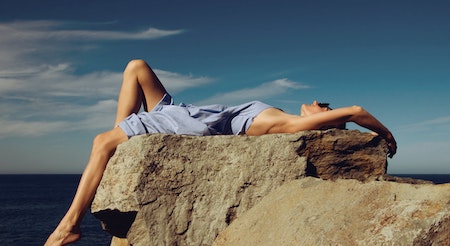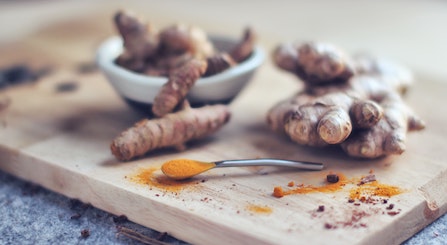
07/07/2021
L’Astaxanthine : le super carotenoïde pour votre peau !
Voici un nutriment majeur qui permet de lutter contre certaines formes de vieillissement, en particulier celles produites par les rayons du soleil : l’astaxanthine. Ce puissant antioxydant de la famille des caroténoïdes protège la peau du rayonnement UV en neutralisant les radicaux libres. C’est de cette façon également qu’il protège les cellules, les organes et les tissus contre le stress oxydatif. Grâce à sa structure moléculaire unique, l’astaxanthine est en effet le meilleur capteur connu à ce jour de radicaux libres générés par les rayons UV. Mais d’où vient cette molécule ? Comment est-elle capable de préparer notre peau au soleil ? Et comment la consommer ? Focus sur un pigment bon pour la peau, mais pas que…
L’astaxanthine : un pigment antioxydant superpuissant
L’astaxanthine est un pigment naturel qui appartient à la grande famille des caroténoïdes. Ce pigment est issu de plusieurs genres de planctons et d’algues unicellulaires, mais sa source la plus concentrée provient de l’algue d’eau douce Haematococcus pluvialis. Le saumon, le krill, les crustacés, le homard et les flamands roses se nourrissent de cette micro-algue, ce qui explique leur couleur rosée. L’astaxanthine possède des bienfaits antioxydants supérieurs à ceux du bêta-carotène et contient également d’autres caroténoïdes importants comme la lutéine, la canthaxanthine et le bêta-carotène.
Son rôle à l’état naturel
Dans la nature, le rôle de l’astaxanthine est de protéger les micro-algues lorsqu’elles sont soumises à un stress extérieur, comme la dégradation de leur habitat naturel, le déficit d’azote ou un trop fort rayonnement du soleil. Ce nutriment joue également un rôle prépondérant dans le renforcement de l’organisme des espèces qui en sont les plus grandes consommatrices. Le saumon sauvage par exemple accumule l’astaxanthine dans ses muscles et peut en contenir jusqu’à 40 mg par kilo. Cela explique en partie sa grande résistance à l’effort, puisqu’il peut en effet parcourir des centaines de kilomètres en nageant à contre-courant.
Ce qui rend l’astaxanthine unique !
Ce pigment rouge est l’un des éléments naturels ayant le plus de potentiel dans le domaine nutraceutique en raison de sa structure chimique particulière.
-
Protection cerveau & yeux: l’astaxanthine est le seul antioxydant à pouvoir traverser la barrière hémato-méningée ainsi que la barrière hémato-rétinienne. Le cerveau et les yeux bénéficient ainsi de ses bienfaits, tout comme l’ensemble des cellules de l’organisme.
-
Protection intégrale des cellules : tandis que les autres antioxydants agissent uniquement à l’intérieur de la membrane cellulaire, l’astaxanthine est capable de se positionner à l’intérieur et à l’extérieur de la paroi cellulaire pour englober la cellule dans son entier.
-
Un antioxydant pur : cet antioxydant a la particularité de ne pas devenir pro-oxydante. Contrairement à de nombreux antioxydants, l’astaxanthine ne se convertit pas dans le corps humain en vitamine A (rétinol), dont l’excès est dangereux pour l’homme.
-
Allié de la peau : cette molécule a la particularité de protéger la peau des effets néfastes du soleil et de favoriser l’hydratation et l’élasticité de la peau.
-
Puissante activité antioxydante : l’astaxanthine a une activité antioxydante particulièrement élevée. Elle serait :
-
65 fois supérieure à la vitamine C
-
54 fois supérieure au bêta-carotène
-
15 fois supérieure à la vitamine E
-
20 fois plus élevée que l’astaxanthine synthétique
L’astaxanthine : l’alliée pour protéger votre peau du soleil !
Le rayonnement ultraviolet produit un stress oxydatif au niveau des cellules. Il cause la production de radicaux libres qui peuvent endommager des structures telles que les lipides, les protéines et l’ADN. Les effets antioxydants de l’astaxanthine protègent la peau des effets délétères du soleil et favorise son hydratation et son élasticité. Mais attention, elle ne remplace pas une protection UV, une crème solaire reste indispensable. A l’approche de l’été, il est recommandé de préparer et protéger sa peau avec de l’astaxanthine. Ce pigment vous permettra ainsi de mieux supporter vos expositions au soleil, grâce à sa composition unique et la présence d’autres caroténoïdes…
Les caroténoïdes, le secret d’une peau dorée et resplendissante
La classe d’antioxydants sur laquelle il faut miser en priorité à l’approche des beaux jours est celle des caroténoïdes qui renforcent la pigmentation de la peau, améliorent la tolérance au soleil et apportent une protection aux différents tissus en contact direct avec la lumière (peau, yeux). Les caroténoïdes ont également la propriété de stimuler la production de mélanine – ce pigment qui colore la peau – et s’opposent à l’action immunosuppressive des ultraviolets, soit à la baisse des défenses immunitaires liée aux UV. Ces puissants antioxydants sont donc capables de protéger nos cellules contre les attaques de certains radicaux libres, ce stress oxydatif qui nous rouille de l’intérieur. Parmi les caroténoïdes, nous trouvons le bêta-carotène, le lycopène, la lutéine, la zéaxanthine et bien sûr l’astaxanthine.
L’astaxanthine comme bouclier au vieillissement cutané
Les antioxydants naturels sont des molécules très prisées en dermatologie puisqu’ils permettent de lutter contre les radicaux libres dont l’accumulation est à l’origine de nombreux dégâts au niveau de la peau. L’astaxanthine est reconnue pour protéger la peau des effets des UV, favoriser le bronzage et procurer un teint hâlé. En complément d’une protection solaire, l’astaxanthine contribue à préparer la peau à réagir face à une exposition prolongée au soleil. En raison de sa capacité à protéger des dommages dus aux rayonnements de la lumière et au photo-vieillissement, l’astaxanthine aide à protéger la peau du vieillissement et à prévenir les érythèmes solaires. Elle contribue à prévenir les coups de soleil et la déshydratation et améliore l’élasticité de la peau. C’est un véritable bouclier cellulaire qui permet de préserver son capital jeunesse et de rendre sa peau plus résistante face au soleil.
Une action choc face aux rayons ultraviolets
Pour comprendre l’action de l’astaxanthine contre le photo-vieillissement cutané, il faut s’intéresser au comportement des cellules lorsque la peau se retrouve exposée aux UV. L’irradiation provoquée par le soleil entraîne une série d’enzymes dont l’activité provoque une dégradation du collagène et des fibres élastiques de la peau. Impliquée dans l’apparition des premiers signes de vieillissement cutané, cette activité enzymatique serait induite et renforcée par les radicaux libres et les cytokines inflammatoires. L’astaxanthine présente un puissant pouvoir antioxydant pour lutter contre les radicaux libres, mais également une activité anti-inflammatoire pour s’opposer aux cytokines inflammatoires. En comparaison au bêtacarotène, l’astaxanthine est capable de neutraliser deux fois plus efficacement les radicaux libres produits dans nos cellules sous l’action des rayons ultraviolets.
Une cure d’astaxanthine vous permettra donc d’aborder le soleil en toute sérénité, grâce à ses actions bénéfiques sur la peau :
-
Prépare la peau à l’exposition au soleil
-
Protège la peau contre les agressions extérieures (rayons UV, pollution)
-
Prévient les rides et les taches de vieillesse
-
Prévient les lucites, ces allergies au soleil touchant particulièrement les femmes
-
Hydrate la peau
-
Ralentit le vieillissement prématuré de l’épiderme
-
Améliore la tonicité, la fermeté et l’éclat du teint
-
Préserve le capital jeunesse de la peau
-
Favorise le bronzage
Comment consommer l’astaxanthine ?
L’astaxanthine n’est pas synthétisable par l’organisme, elle doit donc être fournie par l’alimentation et/ou la supplémentation. Ce caroténoïde est naturellement apporté dans l’alimentation par des produits de mer comme le krill, les crevettes, les homards, le saumon ou d’autres poissons à la chair rouge. Mais il faudrait en manger de trop grandes quantités pour bénéficier de ses effets. La supplémentation est une solution idéale pour préparer et protéger votre peau avant l’été. Assurez-vous de vous procurer de l’astaxanthine naturelle (car il en existe aussi de synthèse), et vérifiez que votre astaxanthine soit passée par un processus d’extraction au CO2 supercritique, comme l’astaxanthine naturelle Green Ethnies. Ce procédé permet de travailler à faible température afin de conserver le meilleur des principes actifs qui sont alors très proches de leur version végétale originale.
Les autres bienfaits de l’astaxanthine
La combinaison des propriétés antioxydantes et anti-inflammatoires de l’astaxanthine lui permet d’agir au-delà des aspects bénéfiques liés à la santé de la peau :
-
Action sur la performance physique : l’astaxanthine permet d’augmenter la force physique et la résistance à l’épuisement, et favorise la récupération musculaire après l’effort.
-
Santé du cerveau : l’astaxanthine améliore les fonctions cognitives et prévient certaines pathologies neurodégénératives associées au stress oxydatif.
-
Protection du système cardiovasculaire : l’astaxanthine joue un rôle dans l’oxydation des lipides, prévenant ainsi l’artériosclérose.
-
Soutien du système immunitaire : l’astaxanthine prévient l’oxydation des cellules.
-
Action anti-inflammatoire : l’astaxanthine bloque les enzymes favorisant l’inflammation, atténuant ainsi les douleurs articulaires (arthrite, tendinite, etc.).
-
Santé digestive : l’astaxanthine aide aux traitements des infections à Helicobacter pylori, des inflammations gastriques et des ulcères.
-
Antidiabétique : l’astaxanthine produit une meilleure réponse à l’hyperglycémie en en améliorant le glucose et l’insuline.
-
Protège les yeux : l’astaxanthine prévient la fatigue oculaire, la sécheresse, la sensibilité au soleil, la dégénération maculaire liée à l’âge et améliore la perception.
-
Amélioration de la fertilité chez l’homme : l’astaxanthine semble augmenter la force et la santé des spermatozoïdes.
Sources
Propriétés biologiques de l’astaxanthine produite par Haematococcus Pluvialis sous conditions de stress. Sadoud Meryem. Thèse de doctorat, 2020.
Astaxanthin in Exercise Metabolism, Performance and Recovery : A Review. Daniel R. Brown, Lewis A. Gough et al. Front Nutr. 2017; 4: 76.
Protective effects of astaxanthin on skin deterioration. K. Tominaga et al., J Clin Biochem Nutr, Juillet 2017, 61(1): 33–39.
Astaxanthin attenuates the UVA-induced up-regulation of matrix-metalloproteinase-1 and skin fibroblast elastase in human dermal fibroblasto. Suganuma K., Nakajima H., Ohtsuki M., Imokawa. Journal of dermatological science. 2010.
Marine Carotenoids against Oxidative Stress : Effects on Human Health. Maria Alessandra Gammone, Graziano Riccioni and Nicolantonio D’Orazio. Mar Drugs. 2015 Oct; 13(10): 6226-6246.
Dietars Suppelmentation with Astaxanthin-Rich Algal Meal Improves Strength Endurance – A Double Blind Placebo Controlled Study on Male Student. Curt L. Malmstena and Ake Lignelle. Carotenoid Science, Vol. 13, 2008 ISSN 1880-5671.
Astaxanthin, canthaxanthin and β-carotene differently affect UVA-induced oxidative damage and expression of oxidative stress-responsive enzymes. Emanuela Camera and al. Experimental Dermatology. October 2008, 18(3):222-31.
La nutraceutique (alicaments) et compléments alimentaires dans le traitement de l’infertilité masculine. Frank Comhaire, Ahmed Mahmoud. Andrologie, 2005, 15. N°1, 41-47.


